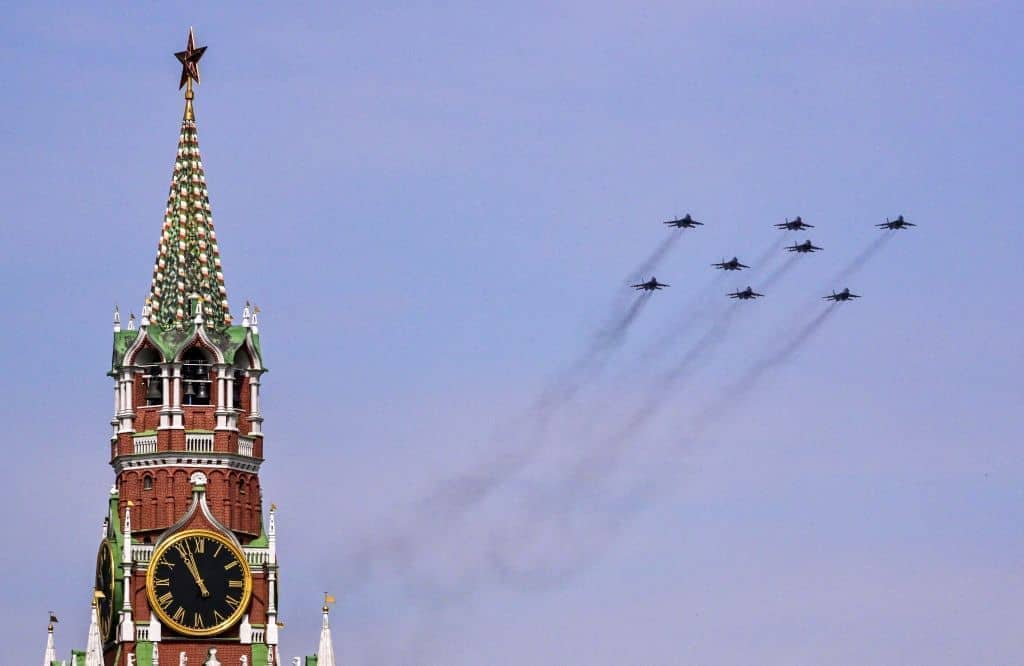In the run up to the Russian invasion in February airpower analysts, including this author, were gloomy about Ukraine’s ability to defend its airspace.
Even the more optimistic assessments assumed that Russia would mount a significant air campaign to destroy the Ukrainian Air Force on its airbases, coupled with large-scale strikes with stand-off cruise and ballistic missiles to blind Ukrainian long range early warning and surface-to-air missile (SAM) system radars. This would have forced Ukraine to move its mobile surface to air missiles away from the frontlines and to try and inflict a steady drumbeat of losses on Russian aircraft penetrating too far. Meanwhile, the defence of Ukrainian frontline units would be mostly left to man-portable air defence systems (MANPADS) to at least make Russian low-level attack runs a dangerous prospect.
When the invasion was launched on 24 February, a barrage of cruise and ballistic missiles struck Ukrainian airbases, munitions dumps, long range SAM positions and radar stations. However, the expected Russian air superiority campaign failed to materialise. Instead, Russian formations of one or two aircraft at a time conducted strikes against targets in and around Ukrainian cities close to the borders including Kyiv, Kharkiv, Sumy, Chernihiv, and Mariupol. Follow up strikes were seldom mounted against targets that were lightly damaged or missed, and Ukrainian mobile SAMs began to inflict losses on both fast jets and helicopters. More significantly, the Russian Air Force (VKS) appeared not to have made plans for a large-scale campaign to suppress and destroy enemy air defences, and also proved unable to coordinate large complex formations that might otherwise have been expected to allow its diverse and modern fast jet fleets to support one another’s strengths and cover weaknesses.
We in the West take large air campaigns almost for granted
Russia’s inability to plan and conduct large, complex aerial strike packages is one of the country’s most significant unforeseen weaknesses during this war, and one that largely explains its inability to establish air superiority over Ukraine.
We in the West take the large air campaigns led by the US Air Force in Iraq, the Balkans and Libya almost for granted, but the level of planning, logistical and command and control capacity required to conduct these complex air operations is enormous. Every pilot involved must be able to understand their role in the entire operation, including precise timings, routes and procedures as part of a comprehensive briefing and planning process before each sortie. Tanker support is critical to ensure that planes have sufficient fuel to complete the expected mission once all the various strike elements have assembled after launching from their disparate bases and transited to the rendezvous points. Coordination between various strike elements is complex even before shooting starts, and once in combat every element in a strike package from escort fighters, fighters tasked with destroying enemy air defences, bombers, electronic warfare escorts and combat search and rescue teams must know exactly what they and all the other force elements are expected to do in any given situation.
Since Russian pilots are trained almost exclusively to fly in pairs and have little exposure to larger exercises; get relatively few flying hours compared to most NATO fighter crews; do not have support from tankers on most operations; and are not doctrinally trained for large air campaigns, it is perhaps unsurprising in retrospect that the Russian Aerospace Forces (VKS)proved incapable of conducting a western-style air war against Ukraine.
However, the consequent inability to rapidly overwhelm and destroy the Ukrainian mobile SAM threat has meant that Russian aircraft soon had to stop flying beyond the immediate frontline areas by day. Even near the frontlines, Ukrainian air defence began to take a significant toll on Russian fighters flying at medium level and MANPADS were a constant danger at lower levels. Flying at very low altitude makes aircraft hard to detect and engage with radar-guided SAMs but it also greatly restricts a pilot’s field of view and leaves aircraft vulnerable to short ranged MANPADS and anti-aircraft fire. As such, night-flying trained Russian Su-34 fighter bomber crews were able to bomb Ukrainian cities near the borders at night when MANPADS operators struggled to spot them, but during low-altitude night attacks they could not reliably hit small or moving targets.
After the collapse of the Russian advance on Kyiv in April, and the redeployment of most Russian forces to the Donbas, Russia slowly gained a measure of freedom to use airpower at medium and high altitudes close to the frontlines. This was achieved by using artillery strikes against Ukrainian short and medium-range missiles which were targeted with drones. Russian fighter patrols also began carrying Kh-31P anti-radiation missiles (which target enemy radar signals) as part of their regular loadout and using them to suppress and occasionally destroy Ukrainian SAMs. This forced Ukrainian SAM operators to be even more careful and keep their radar usage to a minimum, which meant they were more likely to survive but were less effective in combat. Consequently, Russia gained a form of localised air superiority near the frontlines in the Donbas between mid-April and August, making it very difficult for the Ukrainian Air Force to conduct regular strikes itself.
This localised air superiority for Russia in Donbas did not, however, translate into significant levels of battlefield effectiveness against Ukrainian ground forces. The primary reason for this is that despite having more than 300 modern fast jets with theoretically flexible capabilities to carry a range of air-to-air and air-to-ground munitions, most Russian aircrew have had very limited opportunities to drop precision-guided munitions in realistic training scenarios. They also do not have access to targeting pods, which are ubiquitous on most western fighter aircraft. Russia’s ground-attack focused Su-34 fleet does regularly use precision-guided munitions and has a retractable, fixed forward-looking targeting system, but the rest of the Russian fighter fleet has very limited capabilities to find, identify and then precisely strike vehicles and other battlefield targets that do not show up on radar. This means that they have generally been limited to attacking fixed targets with satellite or TV-guided weapons, or dropping unguided bombs and rockets from a low level on coordinates provided by ground troops. In Donbas, this meant that Russian fast jets were largely ineffective in supporting Russian offensive operations against Ukrainian ground forces.
It was in the most recent Ukrainian counter-offensive in Kharkiv Oblast though where the lack of VKS close air support proved more serious. As Ukrainian mechanised forces broke out into the Sevchenkove-Kup’yansk area behind the Russian frontlines on the 7 to 9 September, the lack of significant Russian reserve forces in the area meant that air attack was one of the only tools available to theoretically blunt the Ukrainian thrust.
Here though Ukrainian troops had cover from SA-11 SAM systems moving with the advancing forces, as well as significant numbers of MANPADS and German-supplied Gepard self-propelled anti-aircraft guns. The SAMs meant that Russian jets and helicopters had to stay low to avoid radar-guided engagements, whilst the MANPADS and Gepards made loitering at low level near advancing Ukrainian forces highly dangerous. Coordinates supplied by Russian ground forces were often outdated before they were passed on to Russian pilots due to the fast-moving situation – and with both sides driving many of the same tanks and armoured vehicles, finding and identifying targets would have been extremely difficult for Russian pilots. With only unguided rockets and bombs for most of their available assets, and initial sorties resulting in several losses to MANPADS and Gepard fire, the VKS appears to have made only a token effort to prevent the Ukrainian counter-offensive from reaching Kup’yansk and precipitating the collapse of the entire Izyum front.






Comments